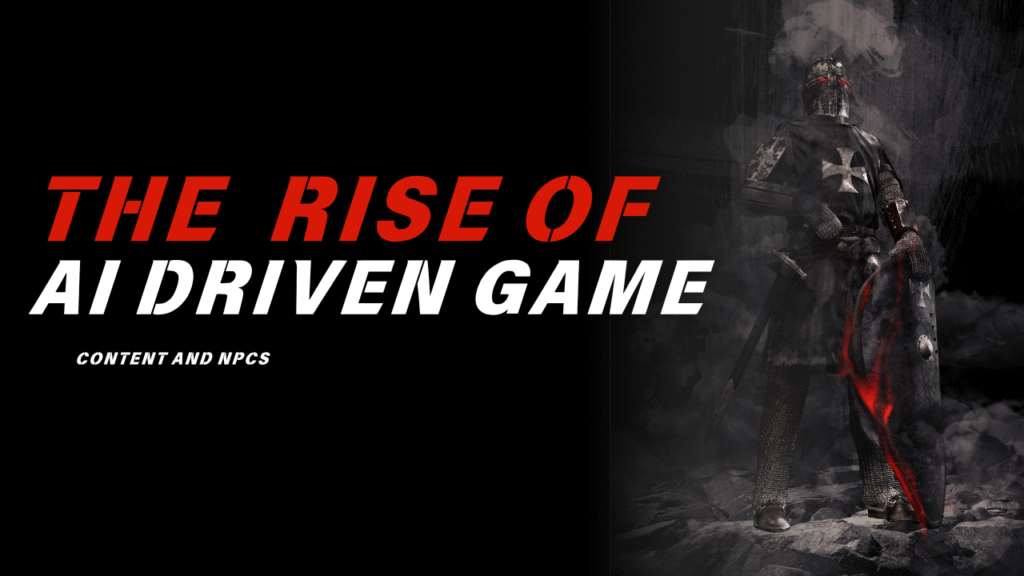
Shaping the Future of Interactive Gaming
In the ever-evolving landscape of video games, artificial intelligence (AI) has rapidly become one of the most transformative technologies. From procedurally generated worlds to dynamic storytelling and intelligent Non-Playable Characters (NPCs), AI is redefining how players interact with games. One of the most exciting developments in 2025 is the use of AI to generate game content and drive more realistic, responsive NPC behavior, fundamentally changing the design and player experience across platforms.
AI in Game Development:
Beyond Procedural Generation
For years, AI was used primarily for procedural generation—creating terrain, dungeons, or item drops in games like Minecraft, No Man’s Sky, or Diablo. Today, however, developers are leveraging powerful generative AI models to create entire game assets: dialogue, environments, soundtracks, and even quest logic. Tools such as Microsoft’s Muse and Inworld AI allow developers to use text prompts or basic outlines to generate high-quality game content in real time.
This shift does not mean replacing human creativity but rather enhancing it. Game developers can now iterate faster, test variations of levels or characters, and focus their energy on higher-level design decisions. The result? More personalized and diverse gaming experiences for players.
Smarter NPCs:
From Scripted to Sentient
Traditionally, NPCs operated on finite state machines or basic decision trees—reacting in predictable, often repetitive ways. With recent AI advancements, NPCs are becoming much more dynamic. Leveraging large language models (LLMs) and behavior modeling, NPCs now engage in fluid, unscripted conversations, respond to player actions with emotional nuance, and even remember past interactions.
Games like Cyberpunk 2077 and The Elder Scrolls VI are integrating AI-powered NPCs that learn from players, form relationships, and evolve over time. This creates more immersive narratives where NPCs feel like actual inhabitants of the game world rather than static quest-givers.
Inworld AI, for example, offers technology that gives NPCs memory, emotion, and motivation—allowing players to form deeper connections with them. Imagine an NPC that not only remembers your past betrayals but changes their behavior accordingly, or one that builds loyalty based on shared goals.
Personalized Gameplay Through AI
With AI monitoring player behavior, in-game systems can now dynamically adjust difficulty levels, mission types, or narrative arcs based on playstyle. A stealth-oriented player may encounter different challenges compared to an aggressive, action-driven one. This adaptability means players are more likely to stay engaged and feel ownership over their gameplay experience.
AI-generated dialogue also enables games to offer near-infinite conversation possibilities. No longer limited to branching dialogue trees, games can create new lines of dialogue in response to player choices, tone, or past actions. This not only enhances immersion but also reduces development bottlenecks in writing and localization.
Ethical Considerations: Bias, Consent, and Ownership
As with all AI applications, using AI to generate game content raises important ethical questions. Bias embedded in training data could lead to problematic NPC behavior or stereotyped content. Developers must be vigilant in curating datasets and testing AI outputs to ensure inclusive and respectful interactions.
There are also questions about ownership—who holds the rights to AI-generated content? If a player helps train an NPC through interaction, do they have creative ownership over that version? Some studios are experimenting with user licenses or blockchain verification to track contributions and compensate creators fairly.
Finally, consent is a rising issue, especially when real-world player data or likenesses are used to train AI systems. Transparency in data usage and clear opt-in policies will be crucial as AI integration deepens.
Benefits to Indie Developers and Modders
Perhaps the most democratizing aspect of AI in game development is how it levels the playing field for smaller studios and solo developers. With access to AI tools, indie developers can generate high-quality assets, characters, and even entire environments with limited resources. This opens the door to more diverse voices and experimental game ideas.
Modding communities are also gaining new tools to create rich, complex modifications. AI can assist in scripting new quests, designing characters, or crafting immersive dialogue—all without needing deep programming knowledge. As a result, community-created content is becoming more expansive and professional than ever before.
Real-World Applications: Training, Therapy, and Beyond
AI-powered NPCs aren’t limited to entertainment. They’re increasingly being used in simulations for military training, language learning, and even therapy. For example, virtual reality training modules featuring lifelike NPCs help soldiers and first responders prepare for real-life interactions.
In mental health, AI NPCs can simulate therapeutic conversations or roleplay anxiety-inducing scenarios in a controlled environment. This opens up possibilities for more affordable, scalable mental health support—though it comes with its own set of risks and regulatory challenges.
Challenges and Future Directions
Despite its potential, AI integration in gaming is not without hurdles. Real-time processing of complex AI models requires significant computational power—raising costs and energy consumption. However, new AI-optimized chips, edge computing, and hybrid models are helping mitigate these limitations.
There’s also a growing need for regulatory frameworks around the use of generative AI in games. Standards for transparency, consent, and digital ethics are still evolving. The gaming industry will need to collaborate across sectors to ensure responsible AI deployment.
Looking forward, we may see NPCs that not only learn and adapt but also collaborate with each other to shape entire game ecosystems. AI dungeon masters, fully adaptive storylines, and persistent world states driven by machine learning are on the horizon.
Conclusion: A New Era of Interactive Entertainment
AI-driven game content and intelligent NPCs are revolutionizing how games are developed, played, and experienced. By enabling dynamic, personalized interactions and automating content creation, AI is empowering both developers and players to engage with virtual worlds in unprecedented ways.
While challenges around ethics, regulation, and technical performance remain, the trajectory is clear: AI is not just a tool but a co-creator in the gaming world. As we stand at the cusp of this transformation, the future of gaming promises to be more immersive, inclusive, and interactive than ever before.